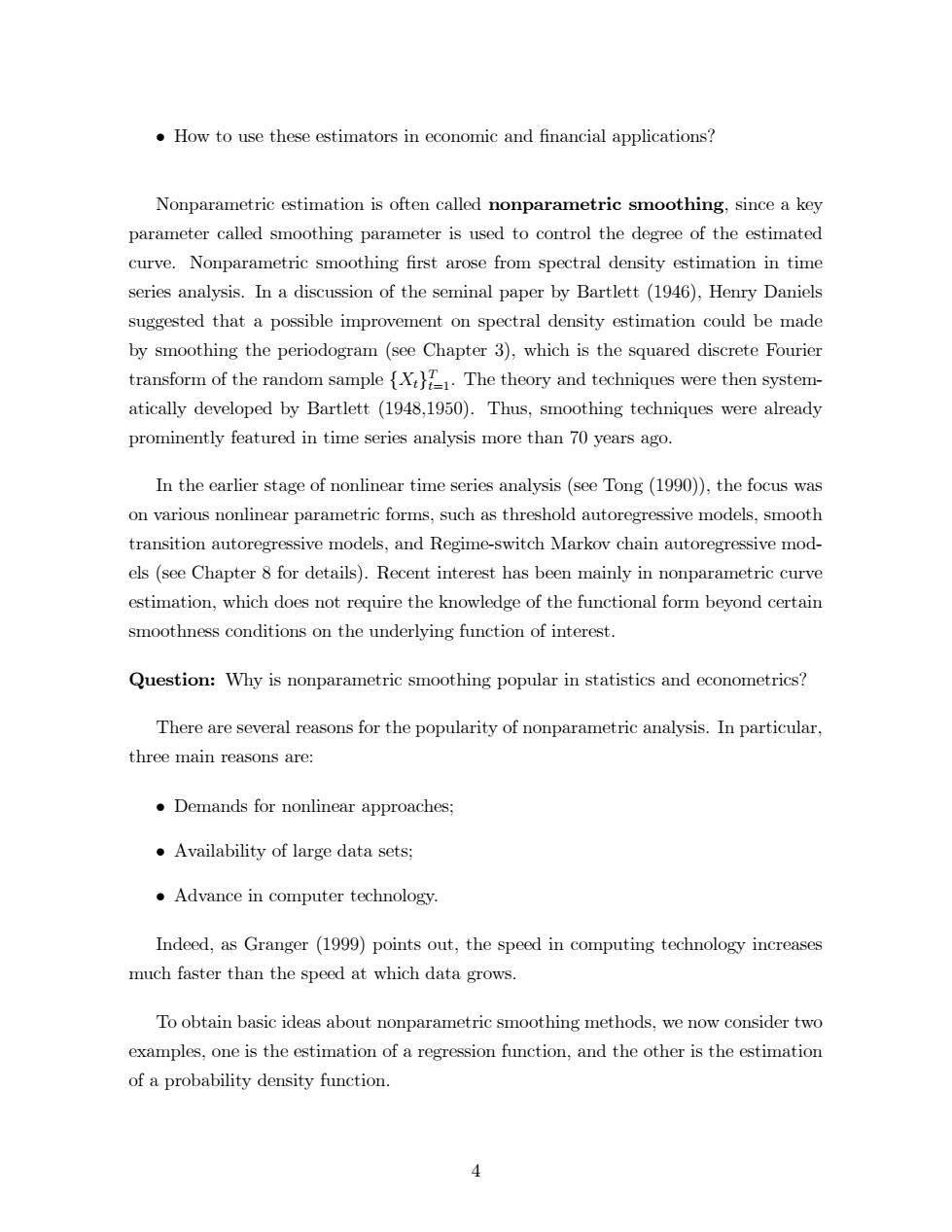正在加载图片...

How to use these estimators in economic and financial applications? Nonparametric estimation is often called nonparametric smoothing,since a key parameter called smoothing parameter is used to control the degree of the estimated curve.Nonparametric smoothing first arose from spectral density estimation in time series analysis.In a discussion of the seminal paper by Bartlett (1946),Henry Daniels suggested that a possible improvement on spectral density estimation could be made by smoothing the periodogram(see Chapter 3),which is the squared discrete Fourier transform of the random sample {X.The theory and techniques were then system- atically developed by Bartlett (1948,1950).Thus,smoothing techniques were already prominently featured in time series analysis more than 70 years ago In the earlier stage of nonlinear time series analysis(see Tong(1990)),the focus was on various nonlinear parametric forms,such as threshold autoregressive models,smooth transition autoregressive models,and Regime-switch Markov chain autoregressive mod- els(see Chapter 8 for details).Recent interest has been mainly in nonparametric curve estimation,which does not require the knowledge of the functional form beyond certain smoothness conditions on the underlying function of interest. Question:Why is nonparametric smoothing popular in statistics and econometrics? There are several reasons for the popularity of nonparametric analysis.In particular, three main reasons are: Demands for nonlinear approaches; Availability of large data sets; Advance in computer technology. Indeed,as Granger (1999)points out,the speed in computing technology increases much faster than the speed at which data grows. To obtain basic ideas about nonparametric smoothing methods,we now consider two examples,one is the estimation of a regression function,and the other is the estimation of a probability density function. ¥ How to use these estimators in economic and Önancial applications? Nonparametric estimation is often called nonparametric smoothing, since a key parameter called smoothing parameter is used to control the degree of the estimated curve. Nonparametric smoothing Örst arose from spectral density estimation in time series analysis. In a discussion of the seminal paper by Bartlett (1946), Henry Daniels suggested that a possible improvement on spectral density estimation could be made by smoothing the periodogram (see Chapter 3), which is the squared discrete Fourier transform of the random sample fXtg T t=1. The theory and techniques were then systematically developed by Bartlett (1948,1950). Thus, smoothing techniques were already prominently featured in time series analysis more than 70 years ago. In the earlier stage of nonlinear time series analysis (see Tong (1990)), the focus was on various nonlinear parametric forms, such as threshold autoregressive models, smooth transition autoregressive models, and Regime-switch Markov chain autoregressive models (see Chapter 8 for details). Recent interest has been mainly in nonparametric curve estimation, which does not require the knowledge of the functional form beyond certain smoothness conditions on the underlying function of interest. Question: Why is nonparametric smoothing popular in statistics and econometrics? There are several reasons for the popularity of nonparametric analysis. In particular, three main reasons are: Demands for nonlinear approaches; Availability of large data sets; Advance in computer technology. Indeed, as Granger (1999) points out, the speed in computing technology increases much faster than the speed at which data grows. To obtain basic ideas about nonparametric smoothing methods, we now consider two examples, one is the estimation of a regression function, and the other is the estimation of a probability density function. 4